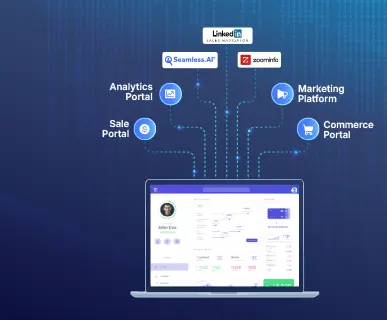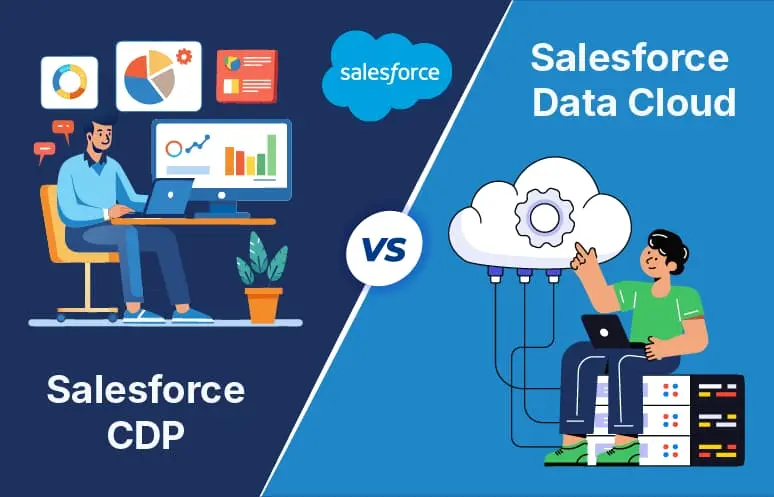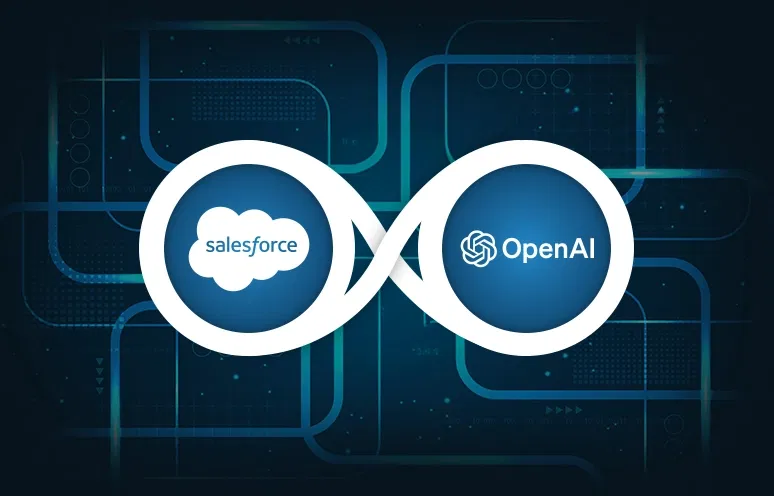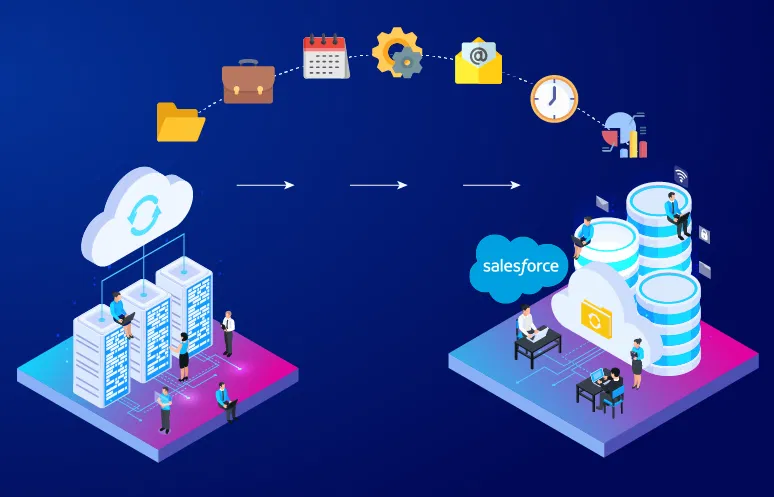Salesforce Customer Data Platform (CDP) and Salesforce Data Cloud are two names that often come up when businesses talk about organizing and using customer data. At first glance, they might seem like different tools for different jobs. However, Salesforce Data Cloud is a step ahead of Salesforce Customer Data Platform and we will discuss this in detail.
Salesforce CDP was originally designed to bring customer data from various sources into one unified profile so businesses could see the complete picture of each customer. Data Cloud, on the other hand, takes that idea further, offering real-time data processing and AI-powered insights at scale.
Think of it like choosing between an old, trusted map and a smart GPS. They both help you navigate, but the experience and capabilities can vary. In this blog, we will explore what’s changed, what each of them offers, and how to choose the best fit for your business goals today.
What is Customer Data Platform (CDP)?
A Customer Data Platform (CDP) is a unified marketing platform through which you can capture behavioral data, create audiences, and synchronize that data with your downstream operational tools for marketing activation.
The purpose of a CDP is to equip you with an integrated platform where you can manage and modify your customer data to help the marketing team build customized experiences for customers. The primary use of CDPs is to improve audience targeting and outreach throughout channels and digital touchpoints such as website visits, social media engagement, email communications, and online ads.
Key features of Salesforce CDP
If you’re looking to personalize customer engagement, the real question isn’t if you need a unified view, but how quickly you can act on it. Salesforce CDP brings that capability closer but knowing what to expect helps you align your strategy with customer behavior.
1. Single customer view
It brings all your customer data together, like purchase history, website activity, and email engagement, so you see each person as one complete profile.
2. Smarter segmentation
Easily group your customers based on behavior or interests to send them more relevant and personalized marketing messages.
3. Marketing automation support
Works smoothly with Salesforce Marketing Cloud, helping you launch targeted campaigns that feel personal and timely.
4. Consent and privacy management
Helps you stay compliant with data privacy rules by managing customer consent and preferences in one place.
5. Predictive insights
Uses built-in AI tools to suggest what a customer might do next, like when they might make a purchase, so you can act ahead of time.

What is Salesforce Data Cloud?
Salesforce Data Cloud is a data lake that is at the center of the whole Salesforce ecosystem, which assists you in bringing all your customer data together so you can build unified customer profiles. It provides your business teams with greater access to customer data so they can drive personalized experiences.
All the Salesforce products operate as their own individual entities using their own architectures. This new platform consolidates all your Salesforce data into a single platform so you can access and share it easily across applications within the Salesforce ecosystem.
Key features of Salesforce Data Cloud
Think of Salesforce Data Cloud as your organization’s central nervous system, built to sense, respond, and adapt in real time. To understand its value, shift from asking “What does it do?” to “How does it change the way we work with data across the business?”
1. Real-time data updates
Keeps your customer and business data fresh by syncing in real time, so you’re always working with the latest information.
2. Connects all data types
Pulls in data not just from marketing, but from sales, service, commerce, and even third-party apps, giving you a 360-degree view of your business.
3. Powerful AI integration
Works with Einstein AI to analyze large volumes of data and deliver smart insights, recommendations, and predictions instantly.
4. Scales across departments
Whether it’s sales, marketing, support, or operations, everyone can access the data they need to make better decisions faster.
5. Plug-and-play flexibility
Easily connects to various tools, platforms, and external systems, so you’re not locked into one ecosystem and can scale as your needs grow.
Key differences between Salesforce CDP and Data Cloud
The conversation around Salesforce CDP vs Data Cloud isn’t just about choosing a tool, it’s about aligning with your data strategy. Knowing how they differ will help you match the right solution to your business goals, not just your current systems.
| Aspect | Salesforce CDP (Customer Data Platform) | Salesforce Data Cloud |
|---|---|---|
| Purpose | Salesforce CDP was built primarily to help businesses collect, unify, and manage customer data from different sources to create a single customer view for better marketing campaigns. | Salesforce Data Cloud is designed as a broader data platform to bring together all kinds of data like customer, transactional, product, and more to support real-time analytics and decision-making across departments. |
| Focus area | It focuses mainly on enhancing marketing and customer engagement by helping businesses understand their customers better and personalize interactions. | It focuses on unlocking value from all enterprise data, not just customer data. It’s meant to support marketing, sales, service, commerce, and more by breaking down data silos across the organization. |
| Data types | Works mostly with structured customer data like demographic info, purchase history, web activity, and CRM records to personalize marketing messages and offers. | Supports a wide variety of data types including structured and unstructured data from CRM, ERP, web, mobile, IoT, social media, third-party platforms, and external data lakes. |
| User persona | Primarily used by marketing teams, digital campaign managers, and CX (Customer Experience) teams who need accurate and real-time customer profiles. | Used by data analysts, IT professionals, business leaders, and operations teams who need cross-functional access to data for insights, reporting, and AI-powered actions. |
| AI and insights | Includes basic AI features, like segmentation and predictive scoring, to deliver more relevant marketing messages and automate customer journeys. | Employs advanced AI models and real-time analytics through tools like Einstein AI to detect patterns, generate insights, and power next-best actions across various business functions. |
| Integration | Integrates well with Salesforce Marketing Cloud and CRM tools to sync customer profiles and run targeted campaigns based on unified data. | Offers deeper and broader integration capabilities, not just within Salesforce ecosystem (sales, service, marketing, commerce), but also with third-party systems, data lakes, cloud services, and APIs. |
| Real-time capabilities | Has limited real-time processing capabilities and mostly works with historical or batch-updated data. Real-time use cases are more restricted. | Built for real-time data ingestion, harmonization, and activation, enabling immediate responses to customer actions or business events. |
| Scale and flexibility | Best for marketing and customer data use cases. It supports a decent volume of customer data but may not scale as efficiently for non-marketing or enterprise-wide data operations. | Built for scalability and high-volume processing. Handles complex, large-scale datasets across departments, supporting enterprise data strategies and AI-driven experiences. |
Salesforce Data Cloud use cases across industries
The beauty of Data Cloud lies in its adaptability. From retail to healthcare to telecom, the platform meets each industry where it is and helps it leap forward. By seeing how different industries apply it through real-world data cloud use cases, you’ll be better prepared to connect its value to your own challenges.
Banking
Salesforce Data Cloud can assist banks in segmenting customers according to their financial position, inclination, and behavior. By examining this data, banks can develop campaigns that can entice certain group of customers. For instance, if a bank identifies customers who are interested in home loans, they can offer them special promotions. This segmentation assists in engaging customers and making them happier.
Manufacturing
Manufacturers can use Salesforce Data Cloud to efficiently handle customer and distributor relationships. By bringing all information on interactions at all touchpoints into a single location, companies can improve communication and service. For instance, manufacturers can monitor orders and give real-time updates of delivery status to customers. This transparency enhances customer satisfaction while enabling manufacturers to accurately forecast demand.
Healthcare
Salesforce Data Cloud helps in developing cohesive patient profiles through aggregation of data from different sources in healthcare. This enables healthcare professionals to better understand their patients to provide personalized care. For instance, health reminders could be sent based on unique patient histories by healthcare specialists. Cohesive profiles result in better patient engagement and health outcomes.
Telecommunications
Telecom operators utilize the Data Cloud to forecast when customers are likely to leave based on their usage patterns. If they see indications that reflect a customer is likely to switch providers such as using less service or complaining, they could take actions to retain them. For instance, they can provide special offers or improved service plans before the customer leaves.
E-commerce
Salesforce Data Cloud can analyze customer behavior and recommend products based on their interests. Based on customer browsing history and previous purchases (or historical information), an ecommerce business may recommend products that match their choices. For instance, if the customer frequently purchases outdoor equipment, the website may recommend new camping gear.
How to choose between Salesforce CDP and Data Cloud
The Salesforce Data Cloud vs CDP choice depends on your business stage, customer needs, and data maturity. Explore the key points to think through what matters most before you decide.
Marketing campaigns
If your biggest goal is creating tailored marketing campaigns with a single customer view, a self-contained CDP may be enough. These systems build a 360-degree picture of your customers and put that data into action through targeted campaigns.
You can use the CDP to segment audiences with precision, personalize email, and serve targeted ads on multiple channels, having your marketing messages resonate with every single customer.
Integrated data across departments
If you want to use customer data across multiple departments, such as sales, service, and marketing, then Data Cloud is a good solution. It has the capability for wider data unification. It extends beyond marketing data, combining data from multiple Salesforce clouds and external sources.
Existing Salesforce investment
Contemplate your current technology foundation. If your company is deeply invested in the Salesforce platform, Data Cloud offers an integrated and native solution. This makes data handling within your current infrastructure much easier.
Data Cloud, as part of the Salesforce Customer 360 ecosystem, provides you with a consistent user experience among different Salesforce products, making it easier to manage data and to drive business processes throughout the organization.
It’s time to do more with your data – Turn insights into your competitive edge
Whether you’re considering Salesforce CDP, Data Cloud, or a blend of both, the goal stays the same: unlocking deeper value from your data.
- Opt for Salesforce CDP if your primary objective is to enhance marketing precision only.
- Choose Salesforce Data Cloud if you want a scalable platform that unifies enterprise-wide data in real time, enables AI-driven insights, and empowers cross-functional teams with actionable intelligence.
There’s been a shift in the data strategies of growing enterprises, in which medium and large businesses are adapting Salesforce Data Cloud for its ability to break down data silos, scale seamlessly across the enterprise, and deliver real-time capabilities. These include continuous data ingestion, dynamic customer profile updates, real-time audience activation, and instant insights across sales, service, and marketing.
To know more about which platform better suits your business, connect with our data experts.
FAQs
What’s the difference between CDP and Data Cloud?
Salesforce CDP focuses mainly on unifying customer data for marketing purposes. Data Cloud is a broader evolution of CDP, built on Salesforce’s Hyperforce platform. It unifies customer data and activates it across all Salesforce applications (Sales, Service, Marketing, Commerce, etc.) in real time. In short, Data Cloud is the next-generation CDP with deeper integrations and expanded capabilities across the full customer journey.
Can I still use Salesforce CDP if I adopt Data Cloud?
Salesforce CDP has been rebranded and upgraded into what is now called Data Cloud. If you’re currently using CDP, you can continue using your setup, but Salesforce encourages migration to Data Cloud to benefit from new features, broader integrations, and real-time capabilities. Once you upgrade, you will find that transitioning to Data Cloud offers a more connected and scalable experience.
Which tool is best for real-time customer personalization across all departments?
Salesforce Data Cloud is designed specifically for real-time customer personalization at scale. It brings together data from multiple sources, applies AI models, and activates insights across departments, whether it’s marketing campaigns, sales engagement, or customer service interactions. With its unified profile and real-time capabilities, Data Cloud helps deliver consistent and personalized experiences at every customer touchpoint.
How does Data Cloud integrate with external AI and BI systems?
Salesforce Data Cloud offers robust integration capabilities through APIs and connectors. It can send and receive data from external AI tools and BI platforms like Tableau, Snowflake, and AWS. This allows businesses to bring advanced analytics and AI-driven insights directly into Salesforce workflows, enabling smarter decision-making and more meaningful customer interactions without data silos.



